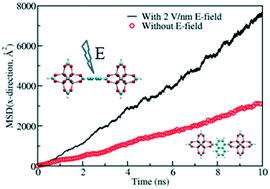当前位置:
X-MOL 学术
›
Mol. Syst. Des. Eng.
›
论文详情
Our official English website, www.x-mol.net, welcomes your
feedback! (Note: you will need to create a separate account there.)
Electric field induced rotation of halogenated organic linkers in isoreticular metal–organic frameworks for nanofluidic applications†
Molecular Systems Design & Engineering ( IF 3.2 ) Pub Date : 2018-10-30 00:00:00 , DOI: 10.1039/c8me00030a Sadanandam Namsani 1, 2, 3, 4 , A. Ozgur Yazaydin 1, 2, 3, 4
Molecular Systems Design & Engineering ( IF 3.2 ) Pub Date : 2018-10-30 00:00:00 , DOI: 10.1039/c8me00030a Sadanandam Namsani 1, 2, 3, 4 , A. Ozgur Yazaydin 1, 2, 3, 4
Affiliation

|
We present a systematic computational study which provides a plausible route to control the rotation of organic linkers in isoreticular metal–organic frameworks (IRMOF) by using an external electric field in order to manipulate the diffusion of molecules in nanopores. We achieve this by halogenating the organic linkers of IRMOF-1 and IRMOF-7 to create permanent dipole moments on the linkers, hence making them responsive to changes in the strength and direction of an electric field. More importantly we show that by varying the ligand size and the halogen type, number and substitution positions, the strength of the electric field required to control the rotation of linkers can be reduced significantly. Cl substitution is most effective in making the organic linkers electric field responsive since a greater dipole moment is created compared to those obtained by F or Br substitution. Cl substitution of a larger organic linker, i.e. 1,4-naphthalenedicarboxylate (IRMOF-7) rather than 1,4-benzenedicarboxylate (IRMOF-1), results in a greater dipole moment and reduces the electric field strength required for the rotation of the ligand. Furthermore, double Cl substitution and the optimization of the Cl substitution positions enable controlled rotation of the IRMOF-7 linkers with an electric field strength as low as 0.5 V nm−1. Finally, using the electric field induced rotation of organic linkers we show that it is possible to enhance the diffusion of methane molecules in a chosen direction while limiting their mobility in other directions. Our study hints at the potential of using MOFs for flow control in nanofluidic systems.
中文翻译:

电场诱导卤化物有机接头在等孔金属有机骨架中的纳米流体应用旋转†
我们提出了一项系统的计算研究,通过使用外部电场来控制分子在纳米孔中的扩散,提供了一条可行的途径来控制等位金属-有机骨架(IRMOF)中有机接头的旋转。我们通过卤化IRMOF-1和IRMOF-7的有机连接基以在连接基上产生永久偶极矩来实现此目的,从而使它们响应电场强度和方向的变化。更重要的是,我们表明,通过改变配体的大小以及卤素的类型,数量和取代位置,可以大大降低控制接头旋转所需的电场强度。Cl取代最有效地使有机接头电场响应,因为与通过F或Br取代获得的偶极矩相比,Cl产生的偶极矩更大。一个较大的有机连接基的Cl取代,即1,4-萘二羧酸(IRMOF-7)而不是1,4-苯二甲酸(IRMOF-1),会导致更大的偶极矩并降低配体旋转所需的电场强度。此外,双Cl取代和Cl取代位置的优化使得IRMOF-7接头的旋转受控,电场强度低至0.5 V nm -1。最后,使用电场诱导的有机连接体旋转,我们表明可以增强甲烷分子在选定方向上的扩散,同时限制其在其他方向上的移动性。我们的研究提示在纳米流体系统中使用MOF进行流量控制的潜力。
更新日期:2018-10-30
中文翻译:

电场诱导卤化物有机接头在等孔金属有机骨架中的纳米流体应用旋转†
我们提出了一项系统的计算研究,通过使用外部电场来控制分子在纳米孔中的扩散,提供了一条可行的途径来控制等位金属-有机骨架(IRMOF)中有机接头的旋转。我们通过卤化IRMOF-1和IRMOF-7的有机连接基以在连接基上产生永久偶极矩来实现此目的,从而使它们响应电场强度和方向的变化。更重要的是,我们表明,通过改变配体的大小以及卤素的类型,数量和取代位置,可以大大降低控制接头旋转所需的电场强度。Cl取代最有效地使有机接头电场响应,因为与通过F或Br取代获得的偶极矩相比,Cl产生的偶极矩更大。一个较大的有机连接基的Cl取代,即1,4-萘二羧酸(IRMOF-7)而不是1,4-苯二甲酸(IRMOF-1),会导致更大的偶极矩并降低配体旋转所需的电场强度。此外,双Cl取代和Cl取代位置的优化使得IRMOF-7接头的旋转受控,电场强度低至0.5 V nm -1。最后,使用电场诱导的有机连接体旋转,我们表明可以增强甲烷分子在选定方向上的扩散,同时限制其在其他方向上的移动性。我们的研究提示在纳米流体系统中使用MOF进行流量控制的潜力。











































 京公网安备 11010802027423号
京公网安备 11010802027423号